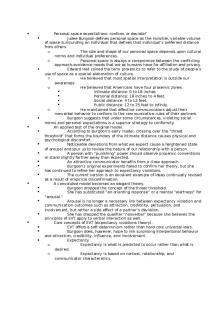Chapter 7 Notes - Expectancy Violations Theory PDF

| Title | Chapter 7 Notes - Expectancy Violations Theory |
|---|---|
| Course | Communication Theory |
| Institution | Sam Houston State University |
| Pages | 3 |
| File Size | 99.5 KB |
| File Type | |
| Total Downloads | 96 |
| Total Views | 163 |
Summary
Chapter 7 Notes - Expectancy Violations Theory...
Description
Chapter 7 Notes Expectancy Violations Theory Judee Burgoon developed the Expectancy Violations Theory
Space Relations Proxemics - study of a person’s use of space personal space - individual’s variable use of space and distance
Proxemic Zones Edward Hall developed 4 proxemic zones: Intimate, Personal, Social, and Public
intimate distance - very close spatial zone spanning 0–18 inches, usually reserved for those whom we share personal feelings personal distance - spatial zone of 18 inches to 4 feet, reserved for family and friends social distance - spatial zone of 4–12 feet, reserved for more formal relationships such as those with coworkers public distance - spatial zone of 12 feet and beyond, reserved for very formal discussions such as between professor and students in class
Territoriality Territoriality - person’s ownership of an area or object
primary territories - signal a person’s exclusive domain over an area or object secondary territories - locations that signal a person’s affiliation with an area or object public territories - locations that signal open spaces for everyone, including beaches and parks
Assumptions of Expectancy Violations Theory Three Assumptions: Expectancies drive human interaction. Expectancies for human behavior are learned. People make predictions about nonverbal behavior.
Influences on Expectancies Expectancies - thoughts and behaviors anticipated in conversations pre-interactional expectations - the knowledge or skills a communicator brings to an interaction interactional expectations - an individual’s ability to carry out the interaction People learn their expectations from both the culture at large and the individuals in that culture. Level of attractiveness can influence distance.
Arousal Arousal - increased interest or attention when deviations from expectations occur cognitive arousal - mental awareness of deviations from expectations (alertness). Our intuitive senses become heightened. physical arousal - bodily changes as a result of deviations from expectations (increased heart rate, moving out of uncomfortable speaking distances, adjusting one’s stance during an interaction, etc.)
Threat Threshold Once arousal exists, threats may occur. threat threshold - tolerance for distance violations
Violation Valence violation valence - perceived negative or positive assessment of an unexpected behavior
Communicator Reward Valence communicator reward valence - the sum of the positive and negative characteristics of a person and the potential for him or her to carry out rewards or punishments
Critique Evaluation Criteria: Scope, Utility, Testability, and Heurism...
Similar Free PDFs

Vroom’s Expectancy Theory
- 3 Pages

EXPECTANCY TEORY
- 31 Pages

Chapter 7 - Lecture notes 7
- 17 Pages

Chapter 7 - Lecture notes 7
- 9 Pages

Chapter 7 - Lecture notes 7
- 11 Pages

Chapter 7 - Lecture notes 7
- 10 Pages

Chapter 7 - Lecture notes 7
- 3 Pages

CH 7 - Chapter Notes
- 7 Pages

Chapter 7 - completed notes
- 24 Pages
Popular Institutions
- Tinajero National High School - Annex
- Politeknik Caltex Riau
- Yokohama City University
- SGT University
- University of Al-Qadisiyah
- Divine Word College of Vigan
- Techniek College Rotterdam
- Universidade de Santiago
- Universiti Teknologi MARA Cawangan Johor Kampus Pasir Gudang
- Poltekkes Kemenkes Yogyakarta
- Baguio City National High School
- Colegio san marcos
- preparatoria uno
- Centro de Bachillerato Tecnológico Industrial y de Servicios No. 107
- Dalian Maritime University
- Quang Trung Secondary School
- Colegio Tecnológico en Informática
- Corporación Regional de Educación Superior
- Grupo CEDVA
- Dar Al Uloom University
- Centro de Estudios Preuniversitarios de la Universidad Nacional de Ingeniería
- 上智大学
- Aakash International School, Nuna Majara
- San Felipe Neri Catholic School
- Kang Chiao International School - New Taipei City
- Misamis Occidental National High School
- Institución Educativa Escuela Normal Juan Ladrilleros
- Kolehiyo ng Pantukan
- Batanes State College
- Instituto Continental
- Sekolah Menengah Kejuruan Kesehatan Kaltara (Tarakan)
- Colegio de La Inmaculada Concepcion - Cebu






